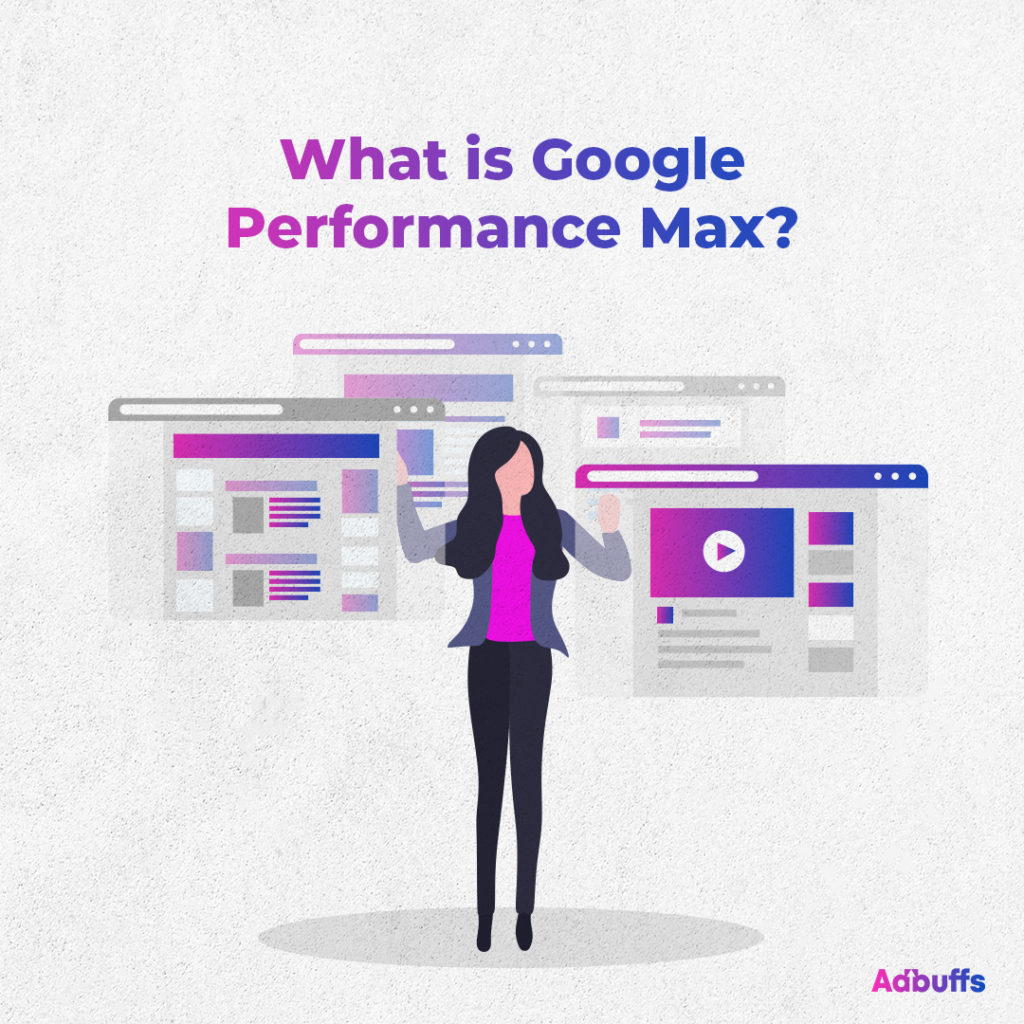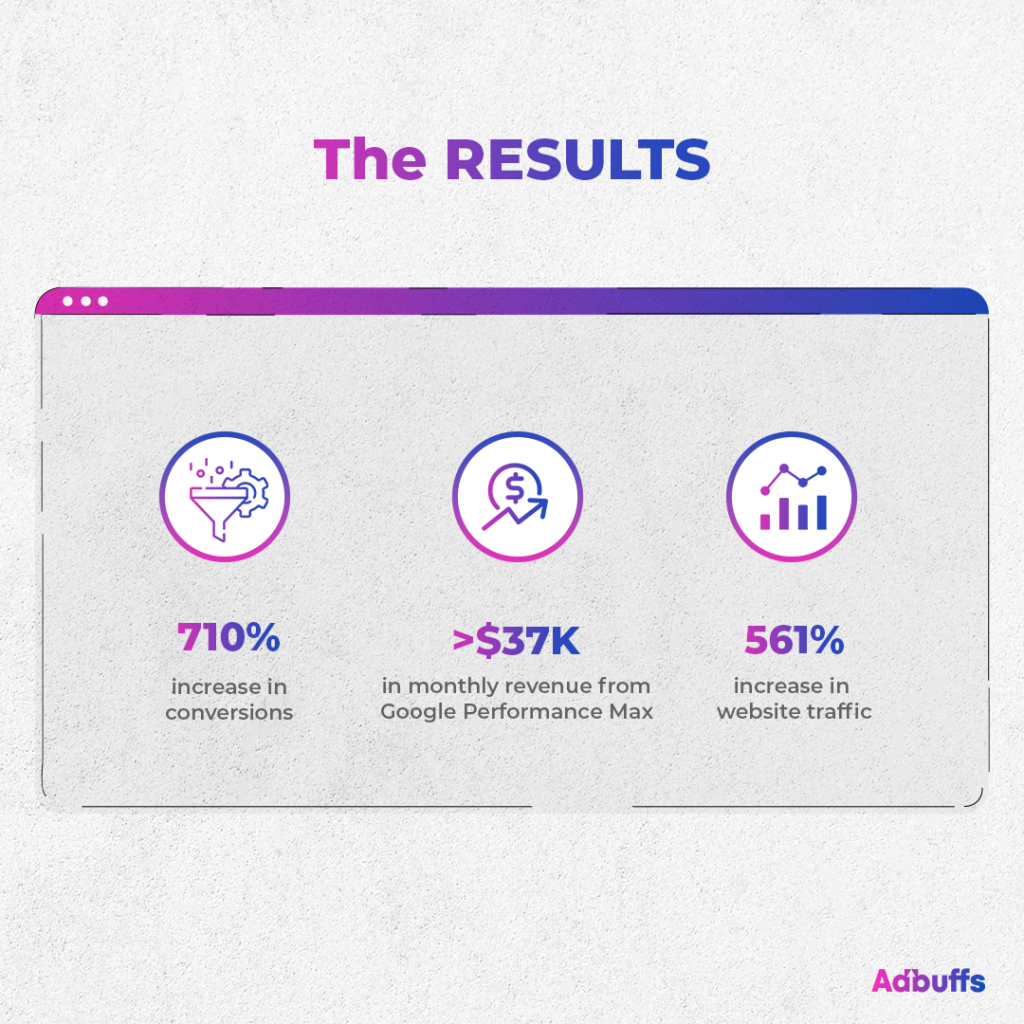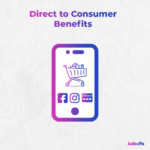
With Google’s announcement that the Performance Max campaign would receive a broader rollout, there have been a lot of questions about what Performance Max is, how it compares to other campaigns, and how it performs. The aim of this article is to answer those frequently asked questions and to help advertisers prepare.
What Is Performance Max on Google Ads?
Google Performance Max is a new goal-based campaign type that, as the name implies, is focused on maximizing performance. Specifically, it’s about optimizing the performance of using Google Ads campaigns to increase conversions.
Think of Performance Max as your all-access advertising pass to the entire Google Network, which includes heavy-hitters like Search, YouTube, Gmail, and Shopping (and that’s not even mentioning Discovery and Display, which are all included as well!).
Not only does Performance Max promise a new, automated way to buy ads across all of Google’s channels from a single campaign, but it also brings deeper insights for the data nerds with machine learning and upgraded reporting capabilities.
While that all sounds amazing, Performance Max isn’t perfect. The timeline before people start to see stable performance seems to be about 6-8 weeks, so you need to test it for a while. And many marketers complain that Performance Max cannibalizes Search campaigns, even though Google says that Search campaigns should be prioritized over Performance Max. However, we’ll show you how to avoid that and other potential pitfalls of Performance Max later in this article.
When To Use Google Performance Max Campaigns
Google recommends you use Performance Max when:
You have specific advertising and conversion goals: We recommend setting SMART goals to get the most out of it.
Your ads aren’t limited to a particular channel: If your ads have limitations, constraints (i.e., budget, time, lack of resources, etc.), or were made for a specific channel, this isn’t the time to use Performance Max. It’s best for campaigns that allow flexibility to adapt in real-time.
You want an all-access pass to Google’s advertising channels using a single campaign: As mentioned before, everything is included here.
You want to take your keyword-based Search campaigns even further: Performance Max will help you reach even more people, which means more conversions.
How Does Performance Max Perform?
One of the biggest differences that separate Google Performance Max campaigns from other Google Ads campaigns is automation and machine learning. With Performance Max, you provide the information (such as campaign goals, budget, and target metrics), and Google handles the targeting and delivery of the ads using Smart Bidding.
Smart Bidding is an automated bid strategy that optimizes for conversion across all channels, allowing for real-time management of bids, budgets, audiences, creatives, attributions, and more.
On top of that, Performance Max also claims to learn what works best through machine learning, meaning it should get better the more you use it. But, as noted above, not everyone has the patience to allow Performance Max the 6 – 8 week runway the Google brain seems to need to learn what works and what doesn’t.
Despite its promises of machine learning-driven automation, you can’t just create a client campaign and leave it to its own devices. Far from it, there is still a lot involved in making sure that Performance Max does what it’s supposed to do.
What Does Performance Max Mean for Agencies?
Performance Max automates a lot of the time-consuming, manual work of setting up a campaign across different platform options. The only thing that agencies have to do with Performance Max is to provide the inputs, then monitor and adjust the campaign as Smart Bidding does its thing to help you achieve your campaign goals.
Similar to CPA targeting, Performance Max campaigns are designed to automatically adjust the various campaign settings to drive the best performance. But, also similar to CPA targeting, this is not a guaranteed result.
Most notable is that Google can only optimize Performance Max campaigns to what it can see. If your campaign goal is to drive leads, the system will optimize to generate the most leads possible within the budget, often coming at the expense of lead quality.
Feedback from marketers across the board indicates that leads from PMax are plentiful and well priced, but tend to be of lower quality. This is an area that Google will need to improve, as low-quality leads put a drain on your client’s budget and sales team resources.
After all, cheap leads don’t mean much if they are converting at a significantly lower level, sometimes as much as 2/3rds lower than other leads from Google Ads.
Although Performance Max is taking another step forward in improved campaign navigation, it has not yet reached “self-drive” status.
But it is a platform that almost every PPC agency should be including in its campaign arsenal in some way, so it’s a good idea to get ahead of the curve and test out some PMax campaigns.
This brings us to the next question…
What Inputs Does Performance Max Use?
The inputs for Performance Max campaigns include:
Campaign goals: This is the most crucial input for Performance Max as these campaign types are goal-based.
Audience signals: Identify who your most valuable audiences are with the highest likelihood of conversion to steer the automation and machine learning algorithms in the right direction. Audience signals are essential, so we’ll return to this later.
High-quality creative: This includes copy, images, and videos. Include your best stuff since there’s only so much automation can do if the creative isn’t up to par.
Conversions: You can identify the most valuable types of conversions for your business
Safety Settings: This was made with brand and account managers in mind as you can specify the types of content where you DON’T want your ads running.
Key Features of Performance Max Campaigns
The latest announcements regarding Performance Max included a few new features that offer agencies more choice when it comes to conversion goals and new types of insights to help you make better decisions driven by data.
Finding New Customers
A new type of conversion setting is now available in Performance Max– Customer Acquisition. This was a popular feature in Smart Shopping campaigns, and its addition to Performance Max only deepens its capabilities.
This goal allows you to focus on new customers–either by bidding more for them or optimizing your campaigns to target only them–while also making it easier to identify them through Customer Match lists, conversion tags, and autodetection.
While this setting may reduce the amount of traffic and increase the cost per lead, it stops your existing customers from seeing the ads (or reduces, if you selected the lower bid option). It only takes a moment to set up, all you need to do is check a box and confirm your audience list of customers.
Audience Signals (Which Are Super Important!)
Audience signals are a new feature unique to Performance Max campaigns that lets you suggest audiences to Google’s machine learning algorithms to optimize conversions.
While it’s optional, we can’t stress the importance of Audience Signals enough and highly recommend using them in your Performance Max campaigns because it nudges the machine learning algorithms in the right direction, namely, toward the audiences who are most likely to convert.
Using strong audience lists is key. If the audience lists are weak or too broad, Performance Max will show your ads to a massive, irrelevant audience.”
Better Insights With More Substance
There are also two new Insights coming to Performance Max:
Asset audience insights: Find out how well specific customer segments respond to the copy, images, and video in your Google Ads. For example, if you’re running a Performance Max campaign to sell computers to power users, you might find they respond better to ads with detailed product specs over flashy product images.
Diagnostic insights: Think of this as a troubleshooter that highlights setup issues that prevent your ads from showing (such as your ads being disapproved) while also providing suggestions on how to fix the problems.
By now, you probably see some of the benefits of using Performance Max (such as it is fully automated as well as an all-access pass to the entire Google Network), but if you and your agency are pros at Smart Shopping and Local campaigns, you might be wondering:
Why Are Google Performance Max Campaigns So Important?
The short answer: Because Performance Max is replacing Smart Shopping and Local campaigns, and it’s happening a lot sooner than you think.
You might have noticed that it has already begun, making it more urgent than ever for agencies to get up to speed on what Performance Max is and what it can do.
Because if you haven’t upgraded your Smart Shopping campaigns by the end of Q3 2022 (i.e. September), you’ll be automatically updated to Performance Max.
Benefits of Google Performance Max Campaigns
The main benefits of Performance Max are:
Access to the entire Google Network: This will take your keyword-based search campaigns to the next level as machine learning serves the right ads to the right people at the right time.
Automation: Using Smart Bidding, all aspects of the bidding and ad buying process are automated, and Performance Max will even generate your ads for you based on the creative assets you provided.
Audience signals: Allow you to steer the machine learning algorithms in the right direction to save time and maximize effectiveness.
Better insights: Includes new features like Asset Audience Insights and Diagnostic Insights.
Goal-focused campaigns: To help you achieve your marketing goals.
In a nutshell, Google Performance Max campaigns are meant to make your clients’ Google Ads campaigns easier to set up and get those ads in front of more people, all the while optimizing performance in real-time.
For a more day-to-day example, here are all the things that an agency would have to run to make up for one Performance Max campaign:
Dynamic search campaign
Display campaign
Discovery campaign
Video campaign (optional)
Smart Shopping campaign
Keep in mind that those campaigns don’t necessarily have the automation capabilities of Performance Max either, so it may be even more labor-intensive to run all those campaigns at once.
What are the Cons of Performance Max?
For one, Performance Max is geared toward novice users as a way to tap into Google Ads with far less knowledge and experience. This goes against the grain of most agencies, which rely on their expertise as a selling point. Ironically, however, novice users tend to fall deeper into the pitfalls of Performance Max precisely because of that lack of experience. These include:
Unclear Goals Lead To Underperforming Campaigns: If you are not crystal clear about the conversion goals you are trying to optimize for, Google will not be able to deliver the results your agency is looking for.
Limited Performance Visibility: At this point in time, it’s difficult to extract specific insights for campaigns or asset combinations. For example, you can’t extract performance data by platform, which makes it difficult to provide actionable reports. It can also make it harder to get client buy-in when you don’t know if the traffic is coming from YouTube, Search or Display! This means your agency can’t easily understand which channels are working or optimize your assets to improve those that aren’t. Although Google is adding more reporting features, it may be a while before agencies can get their hands on the level of data they are used to.
Relying Too Heavily on Automation: If you are not careful about how you set up and optimize Google Performance Max, you could end up wasting a lot of your client’s money on some poorly crafted campaigns.
Loss of Control: The very concept of automation takes some of the control out of the hands of marketing agencies. For those who love to dig through the data to find optimization opportunities, they can only hope that the Google machine is as detailed, and as strategic, as a Google ads expert would be.
In the end, Performance Max has had a polarizing effect on digital marketers across the spectrum. Although Performance Max appears to have some potential, it’s not something that agencies should jump into blindly.
What Network Does Performance Max Run On?
One of the biggest selling points of Performance Max is that it allows agencies to run ads across the entire Google Network, so let’s take a deeper look at what that actually means.
With Google Ads, there are three campaign types to choose from:
Search Campaigns: The text ads shown on Google SERPs (search engine results pages), Google Maps and Shopping, and other Google search partners.
Display Campaigns: The image-based ads that appear throughout the Google Display Network, which includes Gmail, Blogger, and millions of Google-partnered websites and apps.
Video Campaigns: The video ads that run on YouTube.
Performance Max also includes Discovery, and as you can see, it’s a game-changer when it comes to increasing your clients’ ad reach throughout the entire Google ecosystem, and so far, it seems to be living up to the hype.
What Options and Controls Do I Have With Performance Max Campaigns?
Performance Max provides agencies with a wide range of options and controls to tailor their campaigns to their clients’ needs. This includes:
Budget: Determine your conversion goals and set your budget accordingly.
Bidding Strategy: Smart Bidding gives you five strategies to choose from:
Target Cost per Action (CPA)
Target Return on Ad Spend (ROAS)
Maximize Conversions
Maximize Conversion Value
Enhanced Cost per Click (ECPC)
Location: Where will your ads run?
Language: What language?
Ad Scheduling: Choose your schedule and campaign run dates.
URL Options: Choose whether you want Google to send traffic to the most relevant URLs on your clients’ websites or if you want traffic sent to only the URLs you provide.
Asset Groups: These are basically ads, and they’re easy to set up– simply provide the creative (i.e. logos, videos, headlines, etc.) and Google does the rest.
Audience Signals: This is where you can help guide the automated targeting.
Ad Extensions: Choose whether to use existing sitelink extensions or create sitelinks specific to your campaign.

Tips and Tricks for Performance Max:
Here’s a list of tips and tricks to help you get used to Performance Max
You cannot add negative keywords at the platform level, even though this is even more important with a fully automated campaign like Performance Max.
The only way to add negative keywords is to go through your Google Rep. Hopefully, this will change, but there is no ETA. And, to add insult to injury, if you do not have a dedicated Google rep, you have no way to add negative keywords to PMax. Support will not do this. So this is a big red flag for smaller advertisers and agencies.
Performance Max cannibalizes brand bigtime, so if you are running brand campaigns, make extra sure that your brand terms are added as negatives to your Performance Max campaigns.
Make sure to look through the “Insights” tab weekly. This will give you an idea of the type of searches your Performance Max campaigns are appearing on. Scour this religiously and send negative keywords to your Google rep to add.
Do not let Google use your entire website because it will send traffic to the most random, irrelevant pages.
One way to solve this is setting it to only use one URL, but that can be too restrictive so we recommend taking the time to go through your website and exclude the irrelevant URLs.
Don’t just rely on location targeting. It’s best to proactively exclude any country you do not want your ads appearing in.
You have no control over devices because there is no way to exclude mobile devices from PMax. This means if your site/product is not optimized for mobile, you will get a ton of non-converting traffic.
Also, we recommend that anyone using Performance Max to drive leads needs to have a CRM set up and their tracking in place. Many accounts show impressive numbers but the lead quality is often poor so it needs to be monitored.
It’s easy to upgrade to Performance Max. Check your Google Ad account because you might already have a notification for the upgrade. If not, you can find the upgrade tool on Google Ads’ Recommendations page or the Campaigns page.
Once you’ve started the process, you’ll have the choice to either upgrade all of your campaigns at once or pick and choose specific campaigns for upgrades. And don’t worry, your budget and campaign settings will survive.
Everyone will be automatically updated to Performance Max by the end of September 2022, with the bulk of the automatic upgrades which happened in July and August 2022.










